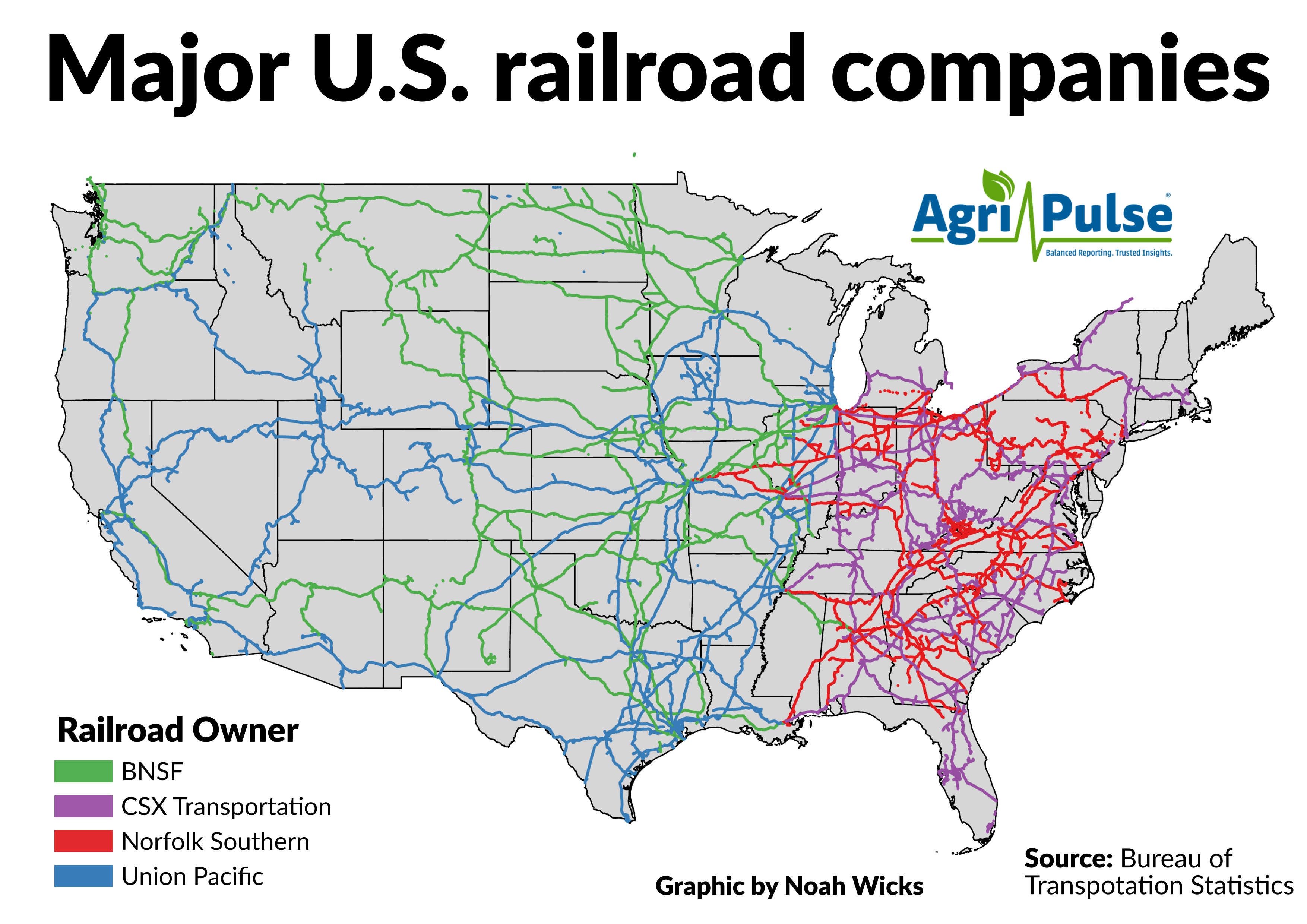The nation's four largest railroad companies have revealed their plans to address the shipping delays plaguing their networks, all relying on one key ingredient: labor.
The railroads, battling a persistent worker shortage, are offering thousand-dollar bonuses, vacation buybacks and extra travel allowances to woo more people into their workforce. All four — Union Pacific, BNSF, Norfolk Southern and CSX Transportation — hope to hire a combined total of more than 6,000 new employees by the end of the year according to documents provided to the Surface Transportation Board and obtained by Agri-Pulse under the Freedom of Information Act.
Railroad companies cut back on staff in 2020 after sudden drops in container traffic, only to be hit by a surge in shipping demand a year later. The companies said in the documents that they're slowly making progress at refilling their workforce, but it remains a primary cause of rail-related delays.
To combat the staffing shortage, BNSF promised to hire 3,000 more employees later this year. Union Pacific set a goal of 2,490 new hires by the end of 2020, while Norfolk Southern said it would employ 628 additional people.
CSX, which did not say how many people it currently employs, said it hopes to have a total of between 7,000 and 7,100 people working on its transportation and engineering team by the end of the year.
Union Pacific is also placing embargoes on products to manage congestion, though it’s a controversial move with agricultural shippers. The railroad first asks customers to reduce their inventory and if they don’t, it restricts how much of the product they can ship.
The practice has drawn criticism from Congress. A group of 51 House Members specifically called out the company for limiting shipments of fertilizer earlier this spring to reduce traffic on rail lines and said continuing the practice would “reduce crop production at a time when our nation and the world can least afford it.”
The legislators, concerned about the recurring complaints from the agricultural industry, sent a letter to the Surface Transportation Board on June 30, asking the agency to address short-term inconsistencies impacting agricultural producers.
“I’m outraged, to be honest,” Rep. Ralph Norman, R-S.C., who co-led the effort with Jim Costa, D-Calif., told Agri-Pulse. “If we can put a man on the moon, we ought to be able to figure out how to get a rail car to farmers who have invested time and borrowed money.”
The initial plans drafted by the railroad companies were given to the board on May 20. But the board, unsatisfied with the initial plans, demanded on June 13 that they be redrafted. The documents, the STB said, left out key information and two of the companies — Union Pacific and Norfolk Southern — even refused to include six-month hiring targets the agency mandated.
“I had expected a better response from the carriers to the board’s previous order, and now with more explicit instructions, which should not have been needed, there will be no excuse for continued lack of compliance,” STB Chairman Martin Oberman said then.
Railroads have also fallen victim to problems snarling other parts of the transportation system: manufacturing delays, port bottlenecks and shifts in consumer activity. All have some level of impact on rail transportation, keeping trains from reaching customers in time.
Don’t miss a beat! It’s easy to sign up for a FREE month of Agri-Pulse news! For the latest on what’s happening in Washington, D.C. and around the country in agriculture, just click here.
Mike Steenhoek, executive director of the Soy Transportation Coalition, likens the nation’s transportation network to a relay race. There’s a runner — ships, trains and trucks — at each leg of the race who must hand the baton off to the next participant until the last one finally reaches the finish line. But if one of the runners falls behind, that means the rest of them will either have to pick up the slack or finish late.
 Mike Steenhoek, Soy Transportation Coalition
Mike Steenhoek, Soy Transportation CoalitionBut the railroads, in particular, have been the subject of scrutiny for their role in the constant delays. Agriculture Secretary Tom Vilsack, along with several agriculture industry groups, in March called on the Surface Transportation Board to act to improve rail service for agricultural commodities, saying the current rail network was at a “breaking point” after railroad companies made cuts in staffing and locomotives.
These cuts, Vilsack said, came at a high cost to farmers, grain elevators and flour and animal feed mills who were unable to get the grain they needed to feed their livestock and keep their businesses operational.
“The staff shortages have caused trains to be held for crews and contributed to congesting the network by impacting our ability to maintain our transit schedules,” Union Pacific wrote. “An inability to maintain schedules leads to the consumption of locomotive resources, as locomotives sit longer than intended and ultimately are not in the proper locations for their next outbound assignments."
The lack of workers makes rail shipping more vulnerable to changes in demand, service outages and weather conditions, all factors that the railroad companies say have been felt on the network at some point in the past year. BNSF, for instance, said massive snowstorms, fires and extreme winds took out sections of its network in April and May.
“A series of extreme weather events that started in late 2021 and continued through the first half of 2022 have caused major disruptions across our network, which was already more fragile given the existing supply chain issues,” BNSF wrote. “And while weather events certainly happen every year … weather-caused service interruptions can have an exaggerated impact on a network that is in recovery mode.”
The revised plans are currently being reviewed by the STB and the railroad companies are having biweekly meetings with the agency to report their progress on easing the delays, according to an agency spokesman.
“To their credit, they're trying,” Steenhoek said in an interview with Agri-Pulse. “They're spending a lot of money for hiring bonuses and they are bringing new employees on.”
For more news, go to www.Agri-Pulse.com.


